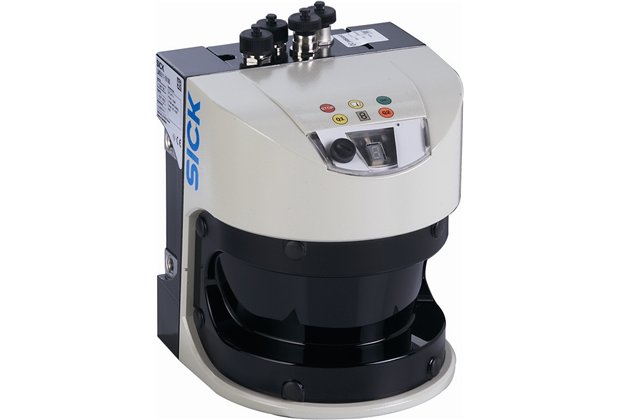SICK LMS511 Laser Scanner – LIDAR Overview
by David Kohanbash on May 12, 2014

This is part of a series of posts talking about some of the common LIDAR’s used in robotics. At the end of these sensor profile articles there will be a final post that compares the sensors based on data collected by each of the sensors.
Posts:
Evaluating LIDAR Guide
LIDAR Fundamentals
SICK TiM551 – LIDAR Overview
SICK LMS111 – LIDAR Overview
SICK LMS511 – LIDAR Overview
Hokuyo UTM-30LX – LIDAR Overview
LIDAR Review Comparisons
I hope this series (and particularly the final comparison post) proves useful.
Enjoy!
SICK LMS511
The SICK LMS511 is the largest of the SICK LIDAR’s commonly found on robots. There are many sub-models in this family for different applications including high and low resolutions models. I would recommend this sensor for applications that need obstacle avoidance/detection at a range up to 40 meters (80 if really needed). I would also recommend this sensor for the most detailed mapping work of this group (especially if you get the high-resolution models).
I need to point out that the “classic” SICK found on robots is the LMS200/LMS291. The LMS511 is a similar size and weight (it actually weighs a little more). The most obvious differences are the multiple returns, larger field of view, ethernet communications, slanted top, and the switch to a small circular connector as opposed to the old large cubes. I like the new connectors since they are smaller and they do not require a gasket that would easy fall off in the old connector in order to be rain proof. I will admit that there was something satisfying about putting in the old connector that is now missing (I am nostalgic). I am guessing there are also changes to the laser beam (shape, size, etc..).
This LIDAR looks and feels very well-built. From personal experience I have seen these sensors survive very rough conditions and handling. I know of a case where a large (and expensive) robot flipped over and was saved by the LIDAR mounted to its front. With that said it is definitely the heaviest LIDAR in the family.
This LIDAR is really good for outdoor robots. It has 6 inbuilt sensors that detect if the LIDAR screen is dirty and no longer safe to be relied on. You can configure how strict the LIDAR is in interpreting those 6 “dirt” sensors. This sensor can also listen for up to 5 returns from a laser pulse. This is important for when only part of a laser beam hits an obstacle and there is more information returned. This situation is commonly encountered with rain and dust situations. The small spot size (especially in the high-resolution models) further helps to “see” through rain and dust as well as penetrate fences and trees (penetrating fences and trees can be good or bad, based on your applications).
The LMS511 has a bunch of other features including digital inputs, digital outputs, and the ability to sync multiple sensors so they do not interfere with each other.
The cables for this sensor come out from the top which is different from many of the other SICK LIDARS. A nice think with all of the SICK’s I am evaluating is that the connectors are all the same (mechanically and electrically) and you can not put the wrong cable onto the wrong connector.
In my data collection the LMS511 kept having some random spurious points. I am not sure why. It might have been some of my settings, or something to do with the multiple returns.
| Range (m) | 0 – 80 (40 with reflectivity below 10%) |
| Field of View (degrees) | 190 |
| Angular Resolution (degrees) | 0.167, 0.25, 0.333, 0.5, 0.667, 1 |
| Scanning Speed (Hz) | 25, 35, 50, 75, 100 |
| Range Accuracy (mm) | ±25 (at <10m), ±35 (from 10m to 20m), and ±50 (from 20m to 30m) |
| Spot Diameter (mm) | 133 at 10m, 252 at 20m, 609 at 50m (standard resolution models) 61 at 10m, 108 at 20m, 250 at 50m (high-resolution models) |
| Wavelength (nm) | 905 |
| Voltage (V) | 24 |
| Power (W) (nominal/max) | 22 (+55 with optional heater) |
| Weight (lb/kg) | 8.16/3.7 |
| Durability (subjective: (poor) 1 – 5 (excellent)) | 5 (It is IP67) |
| Output Interface | Serial, CAN, Ethernet |
| Other | Can synchronize for multiple sensors. Returns up to 5 echos. |
| Cost (USD) | ~7,000 |
Here is an image showing the field of view and range for this sensor:

As a reminder please Click Here to see the final test results from this LIDAR!
I would like to thank SICK for lending me several LIDAR sensors for this review.
Disclaimer: I am only borrowing this LIDAR and will return it when I am done with this evaluation. I have received no money or goods from the company in exchange for this review.


Comments
[…] Guide LIDAR Fundamentals SICK TiM551 – LIDAR Overview SICK LMS111 – LIDAR Overview SICK LMS511 – LIDAR Overview Hokuyo UTM-30LX – LIDAR Overview LIDAR Review Comparisons (coming […]
[…] Guide LIDAR Fundamentals SICK TiM551 – LIDAR Overview SICK LMS111 – LIDAR Overview SICK LMS511 – LIDAR Overview Hokuyo UTM-30LX – LIDAR Overview LIDAR Review Comparisons (coming […]
[…] Guide LIDAR Fundamentals SICK TiM551 – LIDAR Overview SICK LMS111 – LIDAR Overview SICK LMS511 – LIDAR Overview Hokuyo UTM-30LX – LIDAR Overview LIDAR Review […]
[…] Guide LIDAR Fundamentals SICK TiM551 – LIDAR Overview SICK LMS111 – LIDAR Overview SICK LMS511 – LIDAR Overview Hokuyo UTM-30LX – LIDAR Overview LIDAR Review […]
customer service is difficult, hard to make a purchase on their web site.